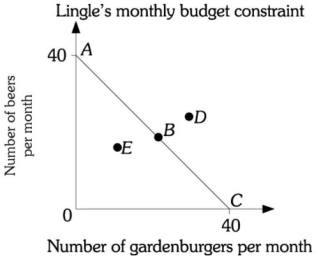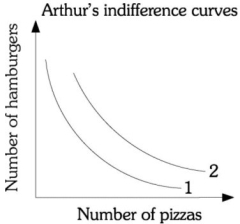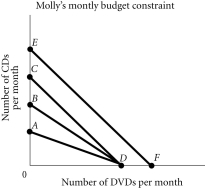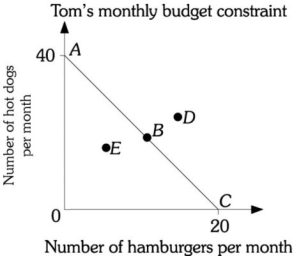A) $1.
B) $4.
C) $10.
D) $40.
Correct Answer

verified
Correct Answer
verified
Multiple Choice
Refer to the information provided in Table 6.2 below to answer the questions that follow. Table 6.2 -Refer to Table 6.2. The marginal utility of the second candy bar per day is
A) 10.
B) 15.
C) 35.
D) 55.
Correct Answer

verified
Correct Answer
verified
True/False
When consumers maximize utility, they are equating the ratio of marginal utility to price across all goods consumed.
Correct Answer

verified
Correct Answer
verified
Multiple Choice
Refer to the information provided in Figure 6.2 below to answer the questions that follow.  Figure 6.2
-Refer to Figure 6.2. Along budget constraint AC, the opportunity cost of one beer is
Figure 6.2
-Refer to Figure 6.2. Along budget constraint AC, the opportunity cost of one beer is
A) 1/4 of a gardenburger.
B) 1 gardenburger.
C) 2 gardenburgers.
D) changing as Mr. Lingle moves down his budget constraint.
Correct Answer

verified
Correct Answer
verified
Multiple Choice
For normal goods,
A) the substitution and income effects of a price decrease will both decrease the quantity of the good demanded.
B) the substitution and income effects of a price decrease will both increase the quantity of the good demanded.
C) the substitution effect of a price decrease will increase the quantity of the good demanded while the income effect of a price decrease will decrease the quantity of the good demanded.
D) the substitution effect of a price decrease will decrease the quantity of the good demanded while the income effect of a price decrease will increase the quantity of the good demanded.
Correct Answer

verified
Correct Answer
verified
True/False
Assuming a perfectly competitive market implies that households have perfect knowledge of qualities and prices of everything available in the market.
Correct Answer

verified
Correct Answer
verified
Multiple Choice
Refer to the information provided in Figure 6.13 below to answer the question that follows.  Figure 6.13
-Refer to Figure 6.13. If Arthur moves from indifference curve 1 to indifference curve 2, then Arthur's
Figure 6.13
-Refer to Figure 6.13. If Arthur moves from indifference curve 1 to indifference curve 2, then Arthur's
A) marginal utility increases.
B) total utility increases.
C) total income decreases.
D) prices of the goods increase.
Correct Answer

verified
Correct Answer
verified
Multiple Choice
Ted has $600 a week to spend on clothing (c) and food (f) . The price of clothing is $30 and the price of food is $5. What is the equation for Ted's budget constraint?
A) $30 × Clothing + $5 × Food < $600
B) $30 × Clothing + $5 × Food ≤ $600
C) $30 × Clothing + $5 × Food > $600
D) $30 × Clothing + $5 × Food = $600
Correct Answer

verified
Correct Answer
verified
Multiple Choice
The diamond/water paradox states that things with the ________ value in use frequently have ________ value in exchange.
A) least; the least
B) least; little or no
C) greatest; little or no
D) greatest; the greatest
Correct Answer

verified
Correct Answer
verified
Multiple Choice
Assume leisure is a normal good. The substitution effect of a wage decrease implies a ________ demand for leisure and a ________ labor supply.
A) lower; higher
B) higher; lower
C) higher; higher
D) lower; lower
Correct Answer

verified
Correct Answer
verified
Multiple Choice
Ellen is spending her entire income on goods X and Y. Her marginal utility from the last units of X and Y that she consumes is 25. Ellen's utility is only maximized if
A) the prices of X and Y are the same.
B) the price of good X is twice that of good Y.
C) the price of good Y is twice that of good X.
D) We cannot determine whether Ellen is maximizing her utility.
Correct Answer

verified
Correct Answer
verified
Multiple Choice
For Matthew, the marginal utility of the 9th soda in a day is positive and the marginal utility of the 10th soda in a day is zero. This
A) implies that Matthew's demand curve for sodas per day will become upward sloping at 10 sodas per day.
B) is impossible because each additional unit of consumption of any good must provide positive marginal utility.
C) implies that at a zero price Matthew's demand curve will intersect the quantity axis at 10.
D) implies that Matthew maximizes utility by consuming 9 sodas per day.
Correct Answer

verified
Correct Answer
verified
Multiple Choice
Refer to the information provided in Figure 6.5 below to answer the questions that follow.  Figure 6.5
-Refer to Figure 6.5. Molly's budget constraint is EF. If her income decreases while the price of the goods are unchanged, her new budget constraint could be
Figure 6.5
-Refer to Figure 6.5. Molly's budget constraint is EF. If her income decreases while the price of the goods are unchanged, her new budget constraint could be
A) AD.
B) BD.
C) CD.
D) not shown on this graph.
Correct Answer

verified
Correct Answer
verified
Multiple Choice
Refer to the information provided in Figure 6.2 below to answer the questions that follow.  Figure 6.2
-Refer to Figure 6.2. Assume Mr. Lingle's budget is AC. Given his current monthly income, he CANNOT purchase the quantities of the two goods at point
Figure 6.2
-Refer to Figure 6.2. Assume Mr. Lingle's budget is AC. Given his current monthly income, he CANNOT purchase the quantities of the two goods at point
A) A.
B) B.
C) E.
D) D.
Correct Answer

verified
Correct Answer
verified
True/False
Homogeneous products are distinguishable from each other.
Correct Answer

verified
Correct Answer
verified
True/False
If MUx/Px exceeds MUy/Py, then a household can increase its utility by spending more on X and less on Y.
Correct Answer

verified
Correct Answer
verified
Multiple Choice
Refer to the information provided in Figure 6.1 below to answer the questions that follow.  Figure 6.1
-Refer to Figure 6.1. Along budget constraint AC, the opportunity cost of one hot dog
Figure 6.1
-Refer to Figure 6.1. Along budget constraint AC, the opportunity cost of one hot dog
A) is 1/4 of a hamburger.
B) is 1/2 of a hamburger.
C) is 2 hamburgers.
D) changes as you move down along the budget constraint.
Correct Answer

verified
Correct Answer
verified
True/False
The diamond/water paradox helps to illustrate the concept of marginal value.
Correct Answer

verified
Correct Answer
verified
Multiple Choice
Refer to the information provided in Table 6.1 below to answer the questions that follow. Table 6.1 -Refer to Table 6.1. The marginal utility of the second hamburger per day is
A) 10.
B) 15.
C) 22.
D) 52.
Correct Answer

verified
Correct Answer
verified
True/False
Assuming the properties of normal indifference curves, a consumer will maximize his utility where his indifference curve is just tangent to his budget constraint.
Correct Answer

verified
Correct Answer
verified
Showing 81 - 100 of 137
Related Exams